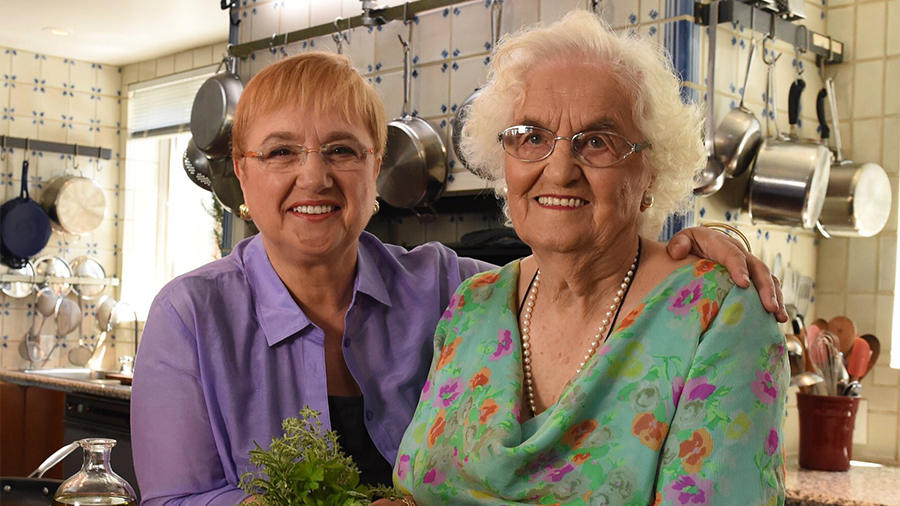Book Review: Chef Lidia Bastianich’s Memoir My American Dream
I love to cook, and my indulgence on some Saturday afternoons is to gorge on PBS cooking shows, often with my computer in my lap while prepping for the week’s classes. Lidia’s Italian Kitchen is the one cooking show I never want to miss. At first, I was attracted to the Italian part of the title, and her accent and intuitive style of cooking brings back memories of my Italian grandma. Yet her cuisine is regional and different from the Italian-American food of my Sicilian and Calabrian Italian ancestry. Lidia comes from a northeast region along the Istrian peninsula, which is now part of Croatia, a country taken from Nazi-allied Italy after World War II and given to Yugoslavia as part of the peace settlement. World leaders and diplomats making deals like this had a catastrophic impact on Lidia’s family.
Lidia’ memoir, My American Dream: A Life of Love, Family, and Food, uncovers a part of history I never knew in its full impact, tells a riveting immigrant American Dream narrative, and reveals an amazing story of a woman who started with nothing, built a creative business empire, all while managing to keep her family close.
A Unique Immigrant Story
Lidia was born just after the end of World War II; and, while Italians tried to flee the Istrian Peninsula to avoid Yugoslavian communist take-over under the Soviet bloc after World War II, her father exercised caution, afraid that Lidia’s birth would be endangered if her mother left home so late in her pregnancy. The picture Lidia paints of the difficult transition her well-educated and successful parents made under communist reign were juxtaposed with idyllic memories of time she spent on her grandparent’s nearby farm. At age 11, unknown to her at the time, her parents developed an escape plan that brought them to Trieste, Italy and two painful years at a refugee camp. Her time at the camp served as a source of shame for her whole life, and late in the memoir — after countless trips back to Italy — she describes in riveting details when she finally mustered the courage to revisit the camp. Her time at the camp was softened by visits to her aunt in Trieste, who helped the family escape and who served as a personal chef. Another kind woman, whose special needs son was tutored by her mother, sponsored Lidia to attend a local Catholic elementary school, which laid a deep faith foundation that has carried her throughout her life and gave her large-scale cooking experience because she worked in the kitchen as part of her scholarship.
Lidia’s family members were some of the first from the refugee camp allowed to migrate to the US after World War II, under legislation that opened the US to more immigrants with education and skills who were fleeing communist countries and through the financial support of Catholic Charities. By telling her story, Lidia placed the current immigration debate in the US in stark relief and offered an earlier model of attitudes and support for immigrants that draws on high American ideals. The historical events and themes that weave through the narrative make this book a valuable contribution to primary source social history for post-World War II US immigration and the history of Italian-American immigrants. Her family came to the US without any money and with a few possessions they carried from charity clothes distributed at the refugee camp. Catholic Charities provided the family with housing, money, got the parents jobs, and set the children up in school. They followed the family for five years to ensure their successful transition to the US.
Lidia’s account of the role she and her brother played in both the refugee camp and in their early years in the US gave a glimpse of how each person in a family carries important responsibilities for the family’s success. Lidia and her brother worked hard to keep their parents cheered up, and they picked up the English language much more quickly than the parents, which led the children to negotiate mortgages, read employment contracts, help the parents set up bank accounts, and facilitated their parent’s successful transition to the US, despite strains that led to countless tears shed by her mother and a persistent melancholy that clung to her father.
A Woman Success Story
Lidia focuses on education as the early foundation for success. She and her brother’s successes in school led to scholarship opportunities. While her brother earned a PhD in engineering, her college education was interrupted by marriage and the birth of her son, who, as a young child struggled with a condition that led him to wear leg braces and delayed his ability to walk. The story of how she raised her children adds a complex and grippingly honest insight into the unique challenges women face managing careers with families. Lidia attributes her ability to hold her children close to her mother, who helped care for the children daily and eventually moved in with Lidia to provide the kind of consistent care that restaurant work did not allow. She also found ways to include her children at her restaurants during after school hours, and eventually both of her children joined the family business.
Lidia and her husband opened two restaurants in Queens and Long Island before they opened up their flagship Manhattan restaurant Felidia, which combined her late husband’s name Felice with her name Lidia. The entrepreneurial story she tells is riveting, and gives a front-line view to the courage it takes to transform ambition into business success. The strains they faced managing loans, renovations, and delays involved dire financial risks that led the family to sell the other two restaurants and to rely on their son’s part-time job at a bagel shop for some of their grocery money, along with support from her parent’s retirement savings. Her mother often chided her at frequent intervals for her ambitions, asking her — Why isn’t what you have enough? But Lidia had a vision, and she took risks, seized opportunities, and persevered.
With a net worth now estimated at $16 million, she owns five restaurants in New York, as well as restaurants in Kansas City, Pittsburgh, Chicago, Los Vegas, Los Angeles, and Boston. She also has a restaurant in Brazil, and she owns wine and olive oil businesses in Italy. A prolific author, she has published eight cookbooks in addition to this 2018 memoir. She branched into television after appearing as a guest with Julia Child, who remained a life-long friend. She has appeared in four different TV series through PBS, and has four Emmy nominations, along with countless awards that span cooking, philanthropy, and Italian-American relations. She also served as the chef for two papal visits, Pope Benedict XVI and Pope Francis, and she tells these stories with insightful details into the personalities of these two popes. She has been a guest at the White House, invited by George and Laura Bush as well as well as the Obamas.
Her rags to riches story is told with humility. She thanks countless individuals and organizations for their support, and considers her mother the difference maker in supporting her business risks and in holding her family close together. Her mother, now 99 years old, appears frequently on her cooking show; her mother’s guest appearances always earn Lidia the greatest fan responses.
My Takeaways
As I fell in love with this book, I knew I wanted to share this treasure with our community, and I kept two lenses in view: what our students can learn from her wisdom and how her story enriches my life as a woman.
For students: As young as age 11, Lidia knew that she had a responsibility to keep her parents spirits up as they managed dire challenges. She consciously worked on this goal. Even while she was in middle school, she came home every day to cook for the family while her parents worked long hours in blue collar jobs. Even though her father had been a successful businessman in the old country and her mother was a respected teacher — and even though their skills positioned them advantageously for access to US immigration — they could never secure professional work in the US because they struggled with mastering English and because they focused their money on investing in their children’s education. Lidia did the shopping with her mother, read the labels, and negotiated the finances. She worked hard in school, grateful for the sacrifices her parents made to pay for her Catholic school education, and both she and her brother earned scholarships that further helped the family as they entered college. She kept her family close, lived close to them, and drew them closer into her home as they aged. Her mother not only cared for her children, but she also helped out at the various restaurants when the children were in school, and her mother brought the children to the restaurants for extra time with their parents. Lidia’s gratitude toward her parents appears in each chapter. She also devotes this book to her grandchildren, so that they carry the family story with them. She ends the book with a challenge to them: “Will someone carry on after us?” She reminds each of you that you are your family’s legacy, and you are responsible for carrying forward and sharing your family’s history.
For women: Lidia’s story of a woman’s success is told with authentic humility and gratitude to others, and she also owns her own success. She identifies herself as a risk-taker and stubborn when she sees a vision, sets a goal, and embarks to bring that vision to success. Her work ethic is breath-taking. She overcame insecurities throughout her life: the shame of her years at a refugee camp and her family’s poverty, the struggle to fit in during her teenage years, getting married younger than her parents wanted, not finishing her college education, breaking into the male-dominated world of top chefs without professional culinary credentials, becoming a TV personality without experience, becoming a writer despite her self-doubts. She remains at the top of her field, with countless culinary awards including a James Beard award, and her success as an international restaurant entrepreneur includes horizontal integration through the export industries in wine and olive oil she owns abroad. She built the olive orchards on the farm she spent with her grandparents in her early years, revealing the importance of gathering your history into your future.
Throughout her story, she struggled with guilt for spending so much time away from her children, yet she worked hard to stay connected, to get all the help she needed for her children, and she has kept her family close and connected over the years. Yet, she unapologetically recognizes that she needed to pursue her passions to be fulfilled. She also testifies to patterns of discrimination against women, especially in getting loans to start businesses. With her successes, she has devoted herself to philanthropy — to give back and make things better for those who follow.
This is a book that will captivate foodies, but it’s a story that is important to help all of us understand the immigrant experience. It gives us a primary source glimpse into world and US history, entrepreneurship, and the challenges women face to pursue career passion and ambition with the needs of their families. Woven throughout the tale is a subtle and persistent message about how her faith foundation laid the groundwork for a life filled with purpose and service.
Mrs. Whitlock, Humanities Coordinator and Looking Glass Advisor
bwhitlock@montroseschool.org















